Related Research Articles
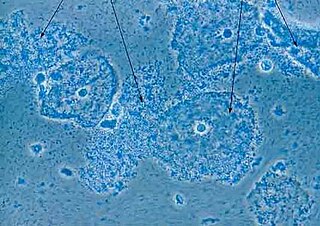
Bacterial vaginosis (BV) is a disease of the vagina caused by excessive growth of bacteria. Common symptoms include increased vaginal discharge that often smells like fish. The discharge is usually white or gray in color. Burning with urination may occur. Itching is uncommon. Occasionally, there may be no symptoms. Having BV approximately doubles the risk of infection by a number of sexually transmitted infections, including HIV/AIDS. It also increases the risk of early delivery among pregnant women.
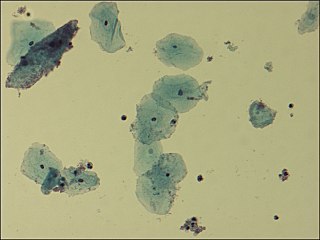
Gardnerella is a genus of Gram-variable-staining facultative anaerobic bacteria of which Gardnerella vaginalis is the only species. The organisms are small non-spore-forming, nonmotile coccobacilli.
Vaginitis, also known as vulvovaginitis, is inflammation of the vagina and vulva. Symptoms may include itching, burning, pain, discharge, and a bad smell. Certain types of vaginitis may result in complications during pregnancy.
Ureaplasma urealyticum is a bacterium belonging to the genus Ureaplasma and the family Mycoplasmataceae in the order Mycoplasmatales. This family consists of the genera Mycoplasma and Ureaplasma. Its type strain is T960. There are two known biovars of this species; T960 and 27. These strains of bacterium are commonly found in the urogenital tracks of human beings, but overgrowth can lead to infections that cause the patient discomfort. Unlike most bacterium, Ureaplasma urealyticum lacks a cell wall making it unique in physiology and medical treatment.
Eubacterium is a genus of Gram-positive bacteria in the family Eubacteriaceae. These bacteria are characterised by a rigid cell wall. They may either be motile or nonmotile. If motile, they have a flagellum. A typical flagellum consists of a basal body, filament, and hook. The long filament is the organ which helps eubacteria move.
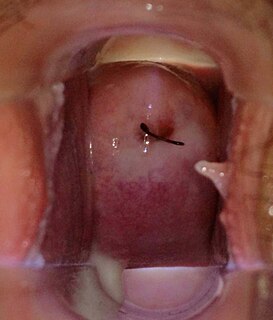
Vaginal discharge is a mixture of liquid, cells, and bacteria that lubricate and protect the vagina. This mixture is constantly produced by the cells of the vagina and cervix, and it exits the body through the vaginal opening. The composition, amount, and quality of discharge varies between individuals and can vary throughout the menstrual cycle and throughout the stages of sexual and reproductive development. Normal vaginal discharge may have a thin, watery consistency or a thick, sticky consistency, and it may be clear or white in color. Normal vaginal discharge may be large in volume but typically does not have a strong odor, nor is it typically associated with itching or pain. While most discharge is considered physiologic or represents normal functioning of the body, some changes in discharge can reflect infection or other pathological processes. Infections that may cause changes in vaginal discharge include vaginal yeast infections, bacterial vaginosis, and sexually transmitted infections. The characteristics of abnormal vaginal discharge vary depending on the cause, but common features include a change in color, a foul odor, and associated symptoms such as itching, burning, pelvic pain, or pain during sexual intercourse.

Clue cells are epithelial cells of the vagina that get their distinctive stippled appearance by being covered with bacteria. The etymology behind the term "clue" cell derives from the original research article from Gardner and Dukes describing the characteristic cells. The name was chosen for its brevity in describing the sine qua non of bacterial vaginosis.
The Nugent Score is a Gram stain scoring system for vaginal swabs to diagnose bacterial vaginosis. The Nugent score is calculated by assessing for the presence of large Gram-positive rods, small Gram-variable rods, and curved Gram-variable rods. A score of 7 to 10 is consistent with bacterial vaginosis without culture. The Nugent Score is now rarely used by physicians due to the time it takes to read the slides and requires the use of a trained microscopist. Bacterial vaginosis diagnosis is done by evaluating the pH, the presences of Lactobacillus spp. versus a mixed flora consisting of Gardnerella vaginalis, Bacteroides spp, Mobiluncus spp, and Mycoplasma hominis. Nugent's test for bacterial vaginosis is performed by measuring the pH, evaluating the presence of clue cells, white discharge an odor of amines after mixing with KOH. Prior to the development of Nugent's test, assessment of bacterial vaginosis was based on culturing G. vaginalis, examining a gram stain of vaginal discharge and gas chromatography.
Fusobacterium nucleatum is an oral bacterium, commensal to the human oral cavity, that plays a role in periodontal disease. This organism is commonly recovered from different monocultured microbial and mixed infections in humans and animals. It is a key component of periodontal plaque due to its abundance and its ability to coaggregate with other bacteria species in the oral cavity.
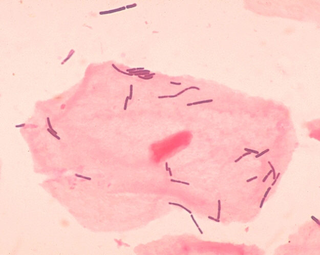
Vaginal flora, vaginal microbiota or vaginal microbiome are the microorganisms that colonize the vagina. They were discovered by the German gynecologist Albert Döderlein in 1892 and are part of the overall human flora. The amount and type of bacteria present have significant implications for a woman's overall health. The primary colonizing bacteria of a healthy individual are of the genus Lactobacillus, such as L. crispatus, and the lactic acid they produce is thought to protect against infection by pathogenic species.
A vaginal disease is a pathological condition that affects part or all of the vagina.
Veillonella parvula is a bacterium in the genus Veillonella. It is a normal part of the oral flora but can be associated with diseases such as periodontitis and dental caries as well as various systemic infections. It has also been isolated from women with bacterial vaginosis and has been associated with hypertension together with Campylobacter rectus and Prevotella melaninogenica.
Prevotella intermedia is a gram-negative, obligate anaerobic pathogenic bacterium involved in periodontal infections, including gingivitis and periodontitis, and often found in acute necrotizing ulcerative gingivitis. It is commonly isolated from dental abscesses, where obligate anaerobes predominate. P. intermedia is thought to be more prevalent in patients with noma.
Tannerella forsythia is an anaerobic, Gram-negative bacterial species of the Cytophaga-Bacteroidetes family. It has been implicated in periodontal diseases and is a member of the red complex of periodontal pathogens. T. forsythia was previously named Bacteroides forsythus and Tannerella forsythensis.
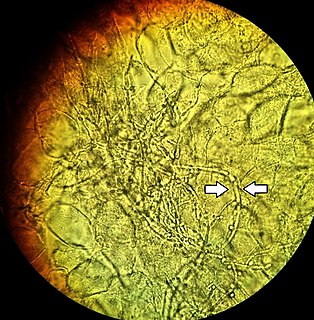
A vaginal wet mount is a gynecologic test wherein a sample of vaginal discharge is observed by wet mount microscopy by placing the specimen on a glass slide and mixing with a salt solution. It is used to find the cause of vaginitis and vulvitis.
Lactobacillus crispatus is a common, rod-shaped species of genus Lactobacillus and is a hydrogen peroxide (H2O2) producing beneficial micro biota species located in both the vagina, through vaginal discharge, and the vertebrate gastrointestinal. The strain CTV-05 is used as a probiotic that can be used by premenopausal and postmenopausal women that experience recurrent urinary tract infections. It is being evaluated specifically for the prevention and treatment of bacterial vaginosis, which is characterized by the absence of lactobacillus flora necessary to protect the host from infection.
The vaginal flora in pregnancy, or vaginal microbiota in pregnancy, is different from the vaginal flora before sexual maturity, during reproductive years, and after menopause. A description of the vaginal flora of pregnant women who are immunocompromised is not covered in this article. The composition of the vaginal flora significantly differs in pregnancy. Bacteria or viruses that are infectious most often have no symptoms.
Janibacter is a genus of Gram positive, nonmotile, non-sporeforming bacteria. The genus name is derived from the two-faced Roman god Janus, referring to the fact that the cells of the original strain could be rod-shaped or coccoid.
References
- 1 2 Maaloum, Mossaab; Diop, Khoudia; Diop, Awa; Anani, Hussein; Tomei, Enora; Richez, Magali; Rathored, Jaishriram; Bretelle, Florence; Raoult, Didier; Fenollar, Florence; Fournier, Pierre-Edouard (23 February 2019). "Description of Janibacter massiliensis sp. nov., cultured from the vaginal discharge of a patient with bacterial vaginosis". Antonie van Leeuwenhoek. 112 (8): 1147–1159. doi: 10.1007/s10482-019-01247-x .